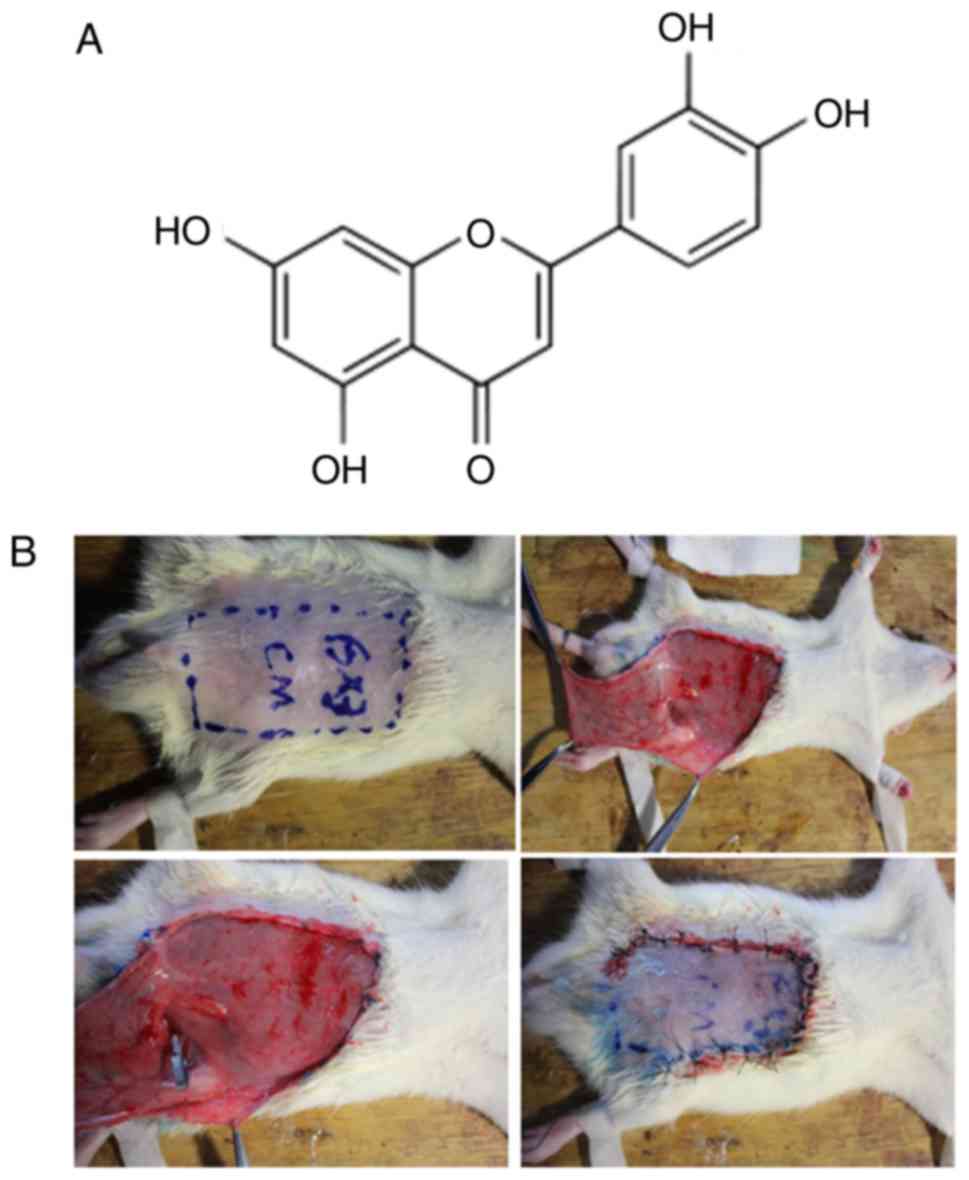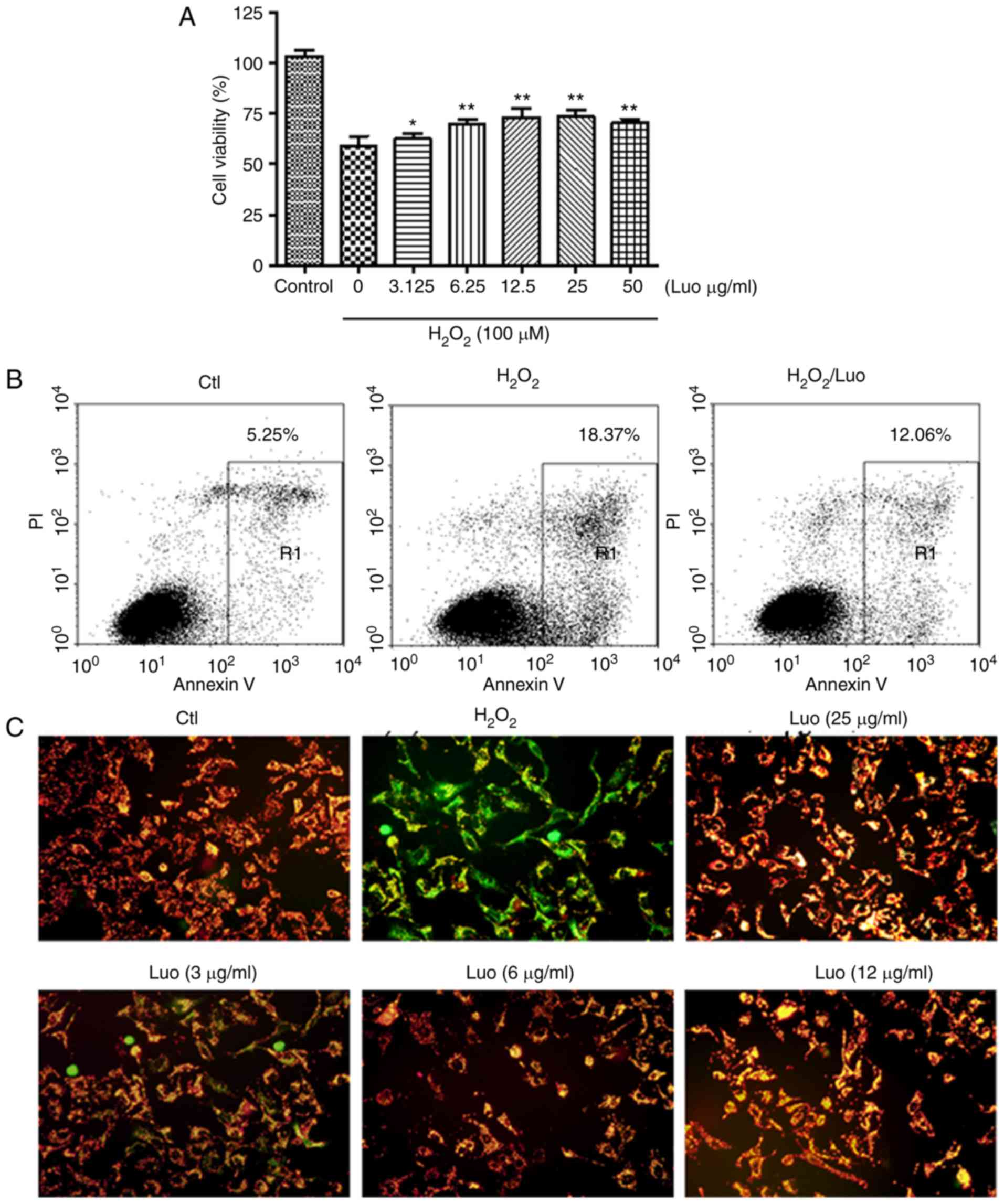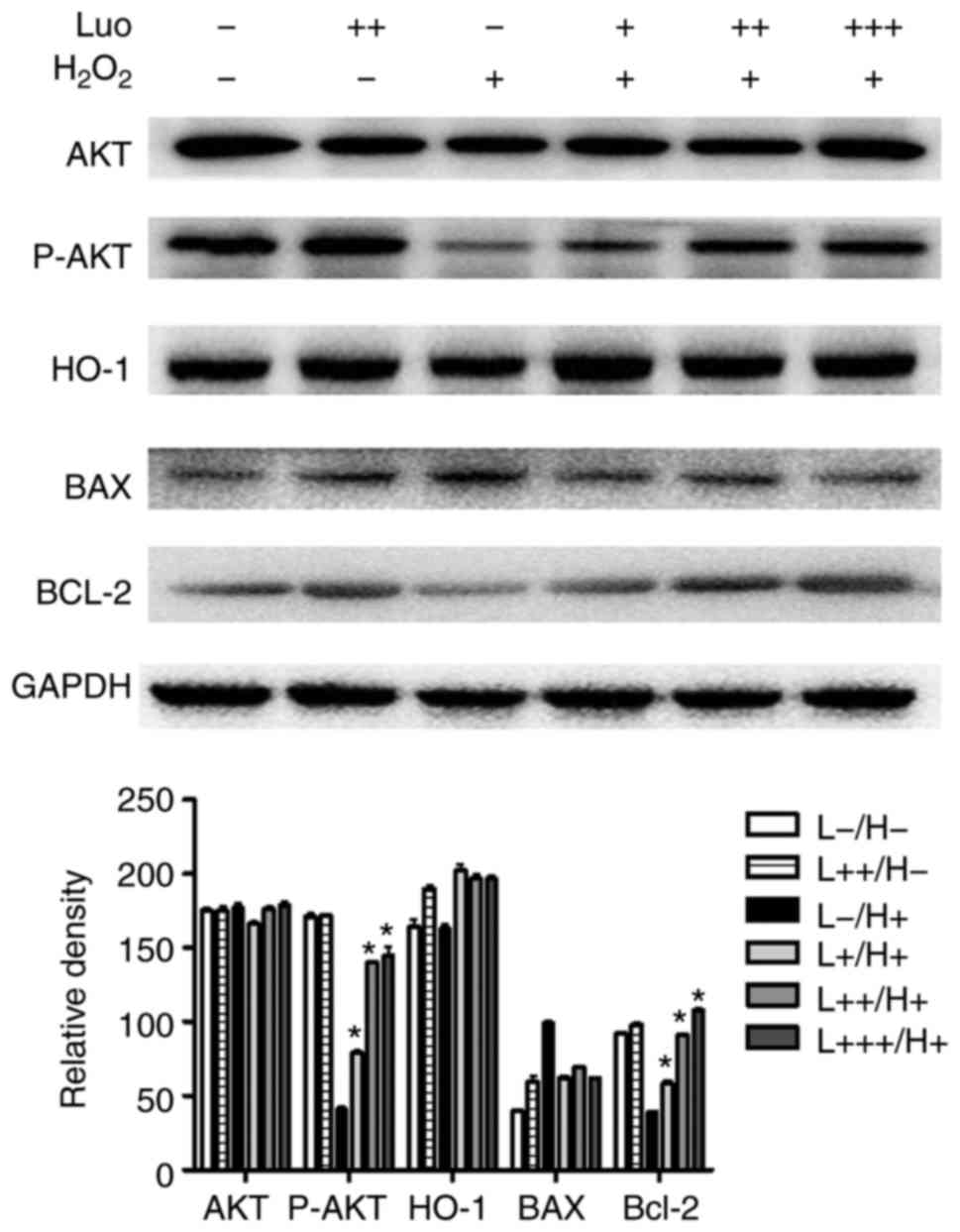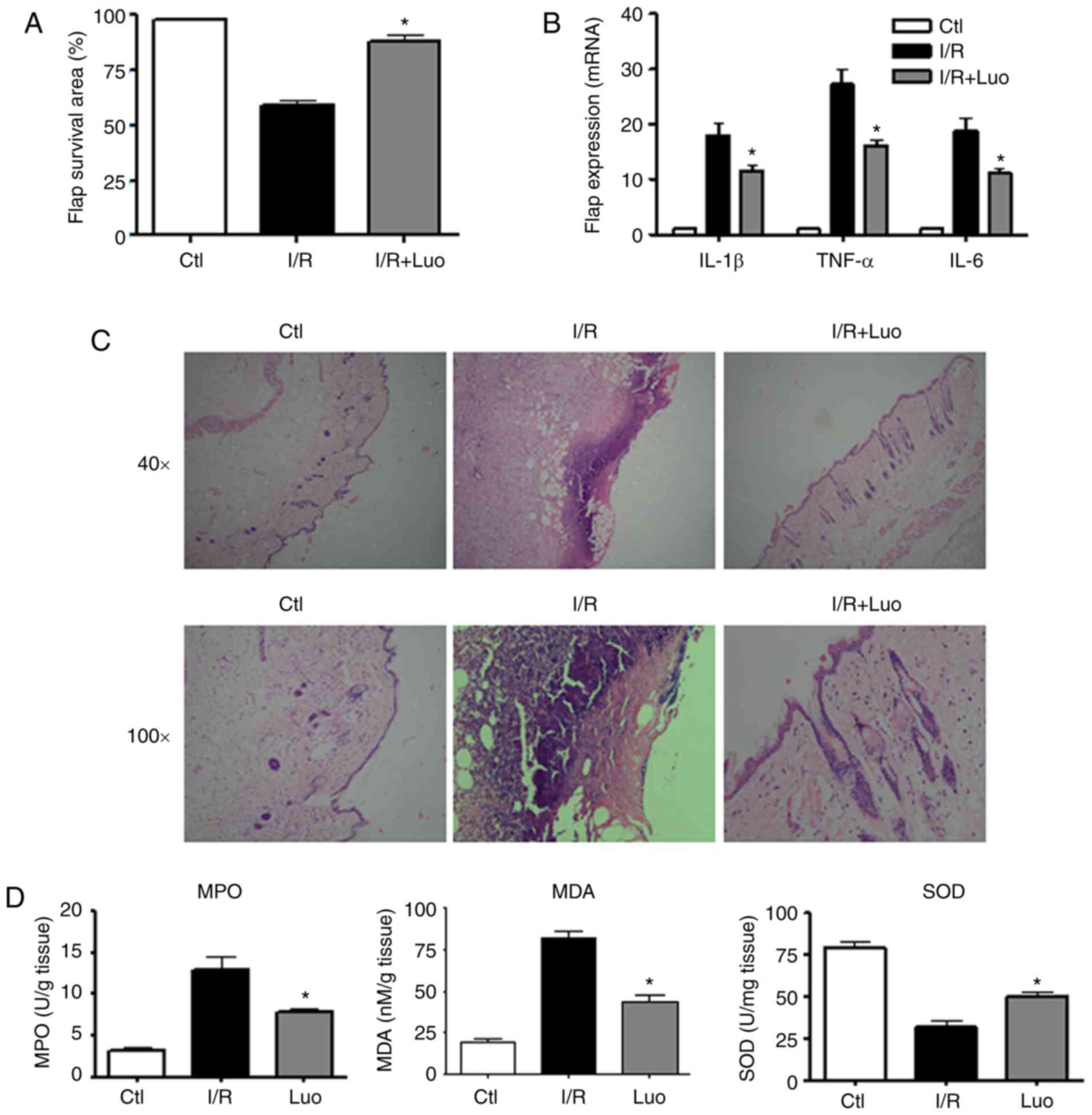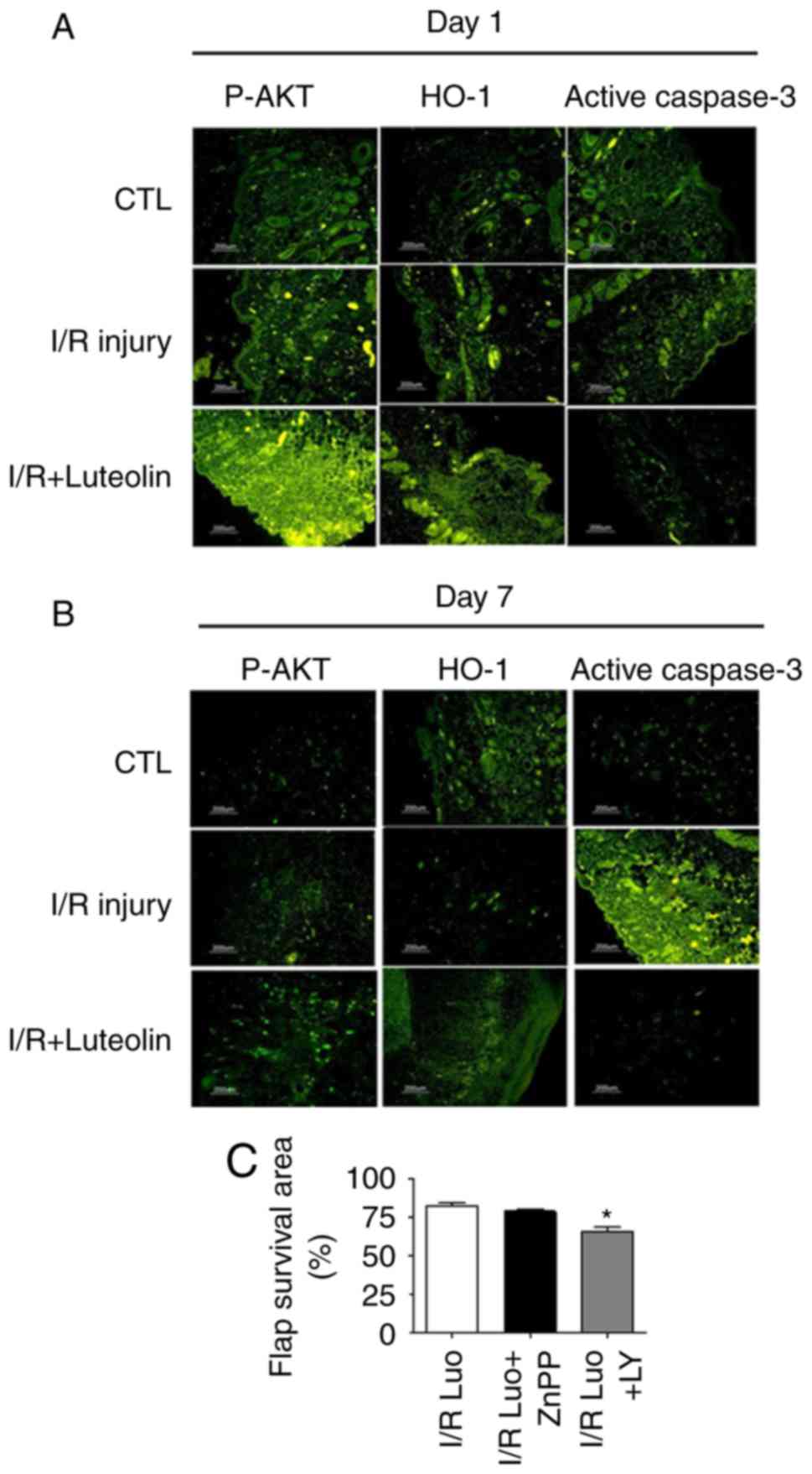|
1
|
Wang X, Takahashi N, Uramoto H and Okada
Y: Chloride channel inhibition prevents ROS-dependent apoptosis
induced by ischemia-reperfusion in mouse cardiomyocytes. Cell
Physiol Biochem. 16:147–154. 2005. View Article : Google Scholar : PubMed/NCBI
|
|
2
|
Park TH and Park YJ: The effect of
botulinum toxin a on ischemia-reperfusion injury in a rat model.
Biomed Res Int. 2017.1074178:2017.
|
|
3
|
Nabavi SF, Braidy N, Gortzi O,
Sobarzo-Sanchez E, Daglia M, Skalicka-Woźniak K and Nabavi SM:
Luteolin as an anti-inflammatory and neuroprotective agent: A brief
review. Brain Res Bull. 119:1–11. 2015. View Article : Google Scholar : PubMed/NCBI
|
|
4
|
Lee JP, Li YC, Chen HY, Lin RH, Huang SS,
Chen HL, Kuan PC, Liao MF, Chen CJ and Kuan YH: Protective effects
of luteolin against lipopolysaccharide-induced acute lung injury
involves inhibition of MEK/ERK and PI3K/Akt pathways in
neutrophils. Acta Pharmacol Sin. 31:831–838. 2010. View Article : Google Scholar : PubMed/NCBI
|
|
5
|
Nunes C, Almeida L, Barbosa RM and
Laranjinha J: Luteolin suppresses the JAK/STAT pathway in a
cellular model of intestinal inflammation. Food Funct. 8:387–396.
2017. View Article : Google Scholar : PubMed/NCBI
|
|
6
|
Das M, Ram A and Ghosh B: Luteolin
alleviates bronchocon-striction and airway hyperreactivity in
ovalbumin sensitized mice. Inflamm Res. 52:101–106. 2003.
View Article : Google Scholar : PubMed/NCBI
|
|
7
|
Shanmugam S, Thangaraj P, Lima B, Lima
BDS, Chandran R, de Souza Araújo AA, Narain N, Serafini MR and
Júnior LJQ: Effects of luteolin and quercetin 3-β-d-glucoside
identified from Passiflora subpeltata leaves against acetaminophen
induced hepatotoxicity in rats. Biomed Pharmacother. 83:1278–1285.
2016. View Article : Google Scholar : PubMed/NCBI
|
|
8
|
Hong X, Zhao X, Wang G, Zhang Z, Pei H and
Liu Z: Luteolin treatment protects against renal
ischemia-reperfusion injury in rats. Mediators Inflamm.
2017.9783893:2017.
|
|
9
|
Yu D, Li M, Tian Y, Liu J and Shang J:
Luteolin inhibits ROS-activated MAPK pathway in myocardial
ischemia/reperfusion injury. Life Sci. 122:15–25. 2015. View Article : Google Scholar
|
|
10
|
Karakas BR, Davran F, Elpek GO, Akbas SH,
Gulkesen KH and Bulbuller N: The effects of luteolin on the
intestinal ischemia/reperfusion injury in mice. J Invest Surg.
27:249–255. 2014. View Article : Google Scholar
|
|
11
|
Gideroglu K, Yilmaz F, Aksoy F, Bugdayci
G, Saglam I and Yimaz F: Montelukast protects axial pattern rat
skin flaps against ischemia/reperfusion injury. J Surg Res.
157:181–186. 2009. View Article : Google Scholar : PubMed/NCBI
|
|
12
|
Kim HJ, Xu L, Chang KC, Shin SC, Chung JI,
Kang D, Kim SH, Hur JA, Choi TH, Kim S and Choi J:
Anti-inflammatory effects of anthocyanins from black soybean seed
coat on the keratinocytes and ischemia-reperfusion injury in rat
skin flaps. Microsurgery. 32:563–570. 2012. View Article : Google Scholar : PubMed/NCBI
|
|
13
|
Yang Y, Zhang Y, Wang Z, Wang S, Gao M, Xu
R, Liang C and Zhang H: Attenuation of acute phase injury in rat
intracranial hemorrhage by cerebrolysin that inhibits brain edema
and inflammatory response. Neurochem Res. 41:748–757. 2016.
View Article : Google Scholar
|
|
14
|
Yoon JJ, Jeong JW, Choi EO, Kim MJ,
Hwang-Bo H, Kim HJ, Hong SH, Park C, Lee DH and Choi YH: Protective
effects of Scutellaria baicalensis Georgi against hydrogen
peroxide-induced DNA damage and apoptosis in HaCaT human skin
keratinocytes. EXCLI J. 16:426–438. 2017.PubMed/NCBI
|
|
15
|
Birk-Sorensen L, Kerrigan CL and Jensen
GS: E-selectin and L-selectin blockade in pure skin flaps exposed
to ischaemia and reperfusion injury. Scand J Plast Reconstr Surg
Hand Surg. 32:365–371. 1998. View Article : Google Scholar : PubMed/NCBI
|
|
16
|
Francis A and Baynosa RC: Hyperbaric
oxygen therapy for the compromised graft or flap. Adv Wound Care
(New Rochelle). 6:23–32. 2017. View Article : Google Scholar
|
|
17
|
Kumar AD, Bevara GB, Kaja LK, Badana AK
and Malla RR: Protective effect of 3-O-methyl quercetin and
kaempferol from semecarpus anacardium against H2O2 induced
cytotoxicity in lung and liver cells. BMC Complement Altern Med.
16:3762016. View Article : Google Scholar :
|
|
18
|
Zhang X, Du Q, Yang Y, Wang J, Dou S, Liu
C and Duan J: The protective effect of Luteolin on myocardial
ischemia/reperfusion (I/R) injury through TLR4/NF-κB/NLRP3
inflammasome pathway. Biomed Pharmacother. 91:1042–1052. 2017.
View Article : Google Scholar : PubMed/NCBI
|
|
19
|
Zhang S, Qi Y, Xu Y, Han X, Peng J, Liu K
and Sun CK: Protective effect of flavonoid-rich extract from rosa
laevigata michx on cerebral ischemia-reperfusion injury through
suppression of apoptosis and inflammation. Neurochem Int.
63:522–532. 2013. View Article : Google Scholar : PubMed/NCBI
|
|
20
|
Sun GB, Sun X, Wang M, Ye JX, Si JY, Xu
HB, Meng XB, Qin M, Sun J, Wang HW and Sun XB: Oxidative stress
suppression by luteolin-induced heme oxygenase-1 expression.
Toxicol Appl Pharmacol. 265:229–240. 2012. View Article : Google Scholar : PubMed/NCBI
|
|
21
|
Kroemer G, Galluzzi L, Vandenabeele P,
Abrams J, Alnemri ES, Baehrecke EH, Blagosklonny MV, El-Deiry WS,
Golstein P, Green DR, et al: Classification of cell death:
Recommendations of the nomenclature committee on cell death 2009.
Cell Death Differ. 16:3–11. 2009. View Article : Google Scholar :
|
|
22
|
Miyata Y, Matsuo T, Sagara Y, Ohba K,
Ohyama K and Sakai H: A mini-review of reactive oxygen species in
urological cancer: Correlation with NADPH oxidases, angiogenesis,
and apoptosis. Int J Mol Sci. 18:E22142017. View Article : Google Scholar : PubMed/NCBI
|
|
23
|
Liu H, Jing X, Dong A, Bai B and Wang H:
Overexpression of TIMP3 protects against cardiac
ischemia/reperfusion injury by inhibiting myocardial apoptosis
through ROS/mapks pathway. Cell Physiol Biochem. 44:1011–1023.
2017. View Article : Google Scholar : PubMed/NCBI
|
|
24
|
Uchiyama A, Yamada K, Perera B, Ogino S,
Yokoyama Y, Takeuchi Y, Ishikawa O and Motegi S: Topical
betamethasone butyrate propionate exacerbates pressure ulcers after
cutaneous ischemia-reperfusion injury. Exp Dermatol. 25:678–683.
2016. View Article : Google Scholar : PubMed/NCBI
|
|
25
|
Uchiyama A, Yamada K, Perera B, Ogino S,
Yokoyama Y, Takeuchi Y, Ishikawa O and Motegi SI: Protective effect
of MFG-E8 after cutaneous ischemia-reperfusion injury. J Invest
Dermatol. 135:1157–1165. 2015. View Article : Google Scholar
|
|
26
|
Johansen C: Generation and culturing of
primary human keratinocytes from adult skin. J Vis Exp.
130:e568632017.
|
|
27
|
Cai Y, Wang W, Liang H, Sun L, Teitelbaum
DH and Yang H: Keratinocyte growth factor improves epithelial
structure and function in a mouse model of intestinal
ischemia/reperfusion. PLoS One. 7:e447722012. View Article : Google Scholar : PubMed/NCBI
|
|
28
|
Zeng C, Jiang W, Zheng R, He C, Li J and
Xing J: Cardioprotection of tilianin ameliorates myocardial
ischemia-reperfusion injury: Role of the apoptotic signaling
pathway. PLoS One. 13:e1938452018. View Article : Google Scholar
|
|
29
|
Xiao YD, Liu YQ, Li JL, Ma XM, Wang YB,
Liu YF, Zhang MZ, Zhao PX, Xie F and Deng ZX: Hyperbaric oxygen
preconditioning inhibits skin flap apoptosis in a rat
ischemia-reperfusion model. J Surg Res. 199:732–739. 2015.
View Article : Google Scholar : PubMed/NCBI
|
|
30
|
Roy AM, Baliga MS and Katiyar SK:
Epigallocatechin-3-gallate induces apoptosis in estrogen
receptor-negative human breast carcinoma cells via modulation in
protein expression of p53 and Bax and caspase-3 activation. Mol
Cancer Ther. 4:81–90. 2005.PubMed/NCBI
|
|
31
|
Liu YQ, Liu YF, Ma XM, Xiao YD, Wang YB,
Zhang MZ, Cheng AX, Wang TT, Li JL, Zhao PX, et al: Hydrogen-rich
saline attenuates skin ischemia/reperfusion induced apoptosis via
regulating Bax/Bcl-2 ratio and ASK-1/JNK pathway. J Plast Reconstr
Aesthet Surg. 68:e147-e1562015. View Article : Google Scholar
|
|
32
|
Salvesen GS: Caspases: Opening the boxes
and interpreting the arrows. Cell Death Differ. 9:3–5. 2002.
View Article : Google Scholar : PubMed/NCBI
|
|
33
|
Ju J, Wu J and Hou R: Role of the p38
mitogen-activated protein kinase signaling pathway in
estrogen-mediated protection following flap ischemia-reperfusion
injury. Cell Biochem Funct. 34:522–530. 2016. View Article : Google Scholar : PubMed/NCBI
|
|
34
|
Zhang B, Zhao Z, Meng X, Chen H, Fu G and
Xie K: Hydrogen ameliorates oxidative stress via PI3K-Akt signaling
pathway in UVB-induced HaCaT cells. Int J Mol Med. 41:3653–3661.
2018.PubMed/NCBI
|
|
35
|
Mahajan UB, Patil PD, Chandrayan G, Patil
CR, Agrawal YO, Ojha S and Goyal SN: Eplerenone pretreatment
protects the myocardium against ischaemia/reperfusion injury
through the phosphatidylinositol 3-kinase/Akt-dependent pathway in
diabetic rats. Mol Cell Biochem. 446:91–103. 2018. View Article : Google Scholar : PubMed/NCBI
|
|
36
|
Jiao S, Zhu H, He P and Teng J: Betulinic
acid protects against cerebral ischemia/reperfusion injury by
activating the PI3K/Akt signaling pathway. Biomed Pharmacother.
84:1533–1537. 2016. View Article : Google Scholar : PubMed/NCBI
|
|
37
|
Kai-lan W and Si Z: Pretreatment with
erythropoietin attenuates intestinal ischemia reperfusion injury by
further promoting PI3K/Akt signaling activation. Transplant Proc.
47:1639–1645. 2015. View Article : Google Scholar : PubMed/NCBI
|
|
38
|
Arslan F, Lai RC, Smeets MB, Akeroyd L,
Choo A, Aguor EN, Timmers L, van Rijen HV, Doevendans PA,
Pasterkamp G, et al: Mesenchymal stem cell-derived exosomes
increase ATP levels, decrease oxidative stress and activate
PI3K/Akt pathway to enhance myocardial viability and prevent
adverse remodeling after myocardial ischemia/reperfusion injury.
Stem Cell Res. 10:301–312. 2013. View Article : Google Scholar : PubMed/NCBI
|
|
39
|
Mason S, Hader C, Marlier A, Moeckel G and
Cantley LG: Met activation is required for early cytoprotection
after ischemic kidney injury. J Am Soc Nephrol. 25:329–337. 2014.
View Article : Google Scholar :
|
|
40
|
Thokala S, Inapurapu S, Bodiga VL, Vemuri
PK and Bodiga S: Loss of ErbB2-PI3K/Akt signaling prevents zinc
pyri-thione-induced cardioprotection during ischemia/reperfusion.
Biomed Pharmacother. 88:309–324. 2017. View Article : Google Scholar : PubMed/NCBI
|
|
41
|
Nath S and Mandal C, Chatterjee U and
Mandal C: Association of cytosolic sialidase Neu2 with plasma
membrane enhances Fas-mediated apoptosis by impairing
PI3K-Akt/mTOR-mediated pathway in pancreatic cancer cells. Cell
Death Dis. 9:2102018. View Article : Google Scholar : PubMed/NCBI
|
|
42
|
Yu T, Gao M, Yang P, Pei Q, Liu D, Wang D,
Zhang X and Liu Y: Topical insulin accelerates cutaneous wound
healing in insulin-resistant diabetic rats. Am J Transl Res.
9:4682–4693. 2017.PubMed/NCBI
|















